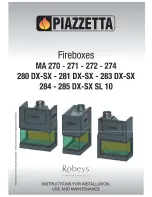
Page 26
7014-188B
February 3, 2010
R
CB1200-I Pellet Insert
R
R
8
Operating Instructions
A. Fuel Size, Material and Storage
1. Wood Pellets
Fuel pellets are made from sawdust or wood by-products. If the
source material is hardwood, they can have a higher mineral
content, creating more ash. Fuels containing bark will also
have higher ash content. Minerals and other noncombustible
materials such as sand will turn into a hard, glass-like substance
called a clinker when heated to the extreme temperatures our
firepot reaches. This is what forms clinkers in the bottom of the
firepot. Trees from different areas will vary in mineral content.
That is why some fuels produce more clinkers than others.
Pellets are manufactured in either 1/4 inch or 5/16 inch (6-8mm)
diameter and should be
no more than 1-1/2 inches (38mm)
in length
. Pellet lengths may even vary by lot from the same
manufacturer which is why the feed rate may need to be adjusted
occasionally.
If you burn pellets longer than 1-1/2 inches
(38mm) you may have an inconsistent fuel feed rate and/or
missed ignitions.
Pellet fuel quality can greatly fluctuate. We recommend using
premium grade fuel with ash content less than 1%. Even in some
fuel labeled “premium” ash content can vary from bag to bag
and possibly exceed 1%. High ash fuel, or lack of maintenance,
can cause the firepot to fill up and thus create a potential for
smoking, sooting and possible hopper fires.
Always burn dry fuel. Burning fuel with high moisture content
takes heat from the fuel and tends to cool the appliance,
robbing heat from your home. Damp pellet fuel can clog the
feed system.
We recommend that you buy fuel in multi-ton lots whenever
possible. Buying large quantities of fuel at once will greatly
reduce the number of times the feed adjustments will need to be
made. However, we do recommend trying various brands before
purchasing multi-ton lots to ensure your satisfaction.
2. Shelled Field Corn
Extensive factory and field testing has demonstrated shelled
field corn to be an efficient and very economical fuel. We
recommend the use of a 50-50 blend of corn and wood pellets.
The only change in operation is that the feed rate may require
a slight adjustment. The BTU output of the appliance varies
slightly compared to pellets, depending on the quality of the
Fire Risk.
WARNING
• High ash fuels, or lack of maintenance, can
cause the firepot to overfill. Follow proper
shutdown procedure if ash buildup exceeds
half way point in firepot.
• Failure to do so could result in smoking,
sooting and possible hopper fires.
2. Shelled Field Corn (Cont’d)
corn used. In cases where it is acceptable for the appliance
to run full time, 100% corn will work after the fire has been
started using wood pellets.
When purchasing corn to burn in your appliance, read the
ingredient label very carefully.
Do NOT purchase fuel
that contains any additives
such as oils (i.e. soybean oil)
and meals as it will result in poor unit performance. If you
are buying corn the only ingredient that should be listed
is corn.
Shelled field corn must be 15% or less moisture content.
The corn must be clean and free from debris. Never burn
corn straight from the field. Stalk parts, excessive fines and
cob remnants, etc. will clog the auger mechanism. Corn
with excessive grain dust must be screened by sifting with
3/16 (4.76mm) inch mesh screening.
Do not burn treated seed corn in your appliance. Seed corn
is treated with chemical pesticides that are harmful or fatal
if swallowed; therefore, seed corn is dangerous to have in
the house, expecially where children can reach it. Burning
treated seed corn in your appliane will void your warranty
and will destroy the exhaust system on the unit.
When changing to a different fuel, be sure to empty the
hopper of the previous fuel and vacuum the hopper before
you fill it with the new fuel.
Risk of Chemical Poisoning.
• Do Not burn treated seed corn
• Chemical pesticides are harmful or fatal if
swallowed
• Burning treated seed corn will void your
warranty
WARNING
3. Storage
Wood pellets should be left in their original sealed bag until
using. This will prevent moisture absorption.
Shelled corn should be stored in a tight container where it
will not absorb moisture from damp or wet floors. This will
also prevent rodents from becoming a problem.
Do not store any pellet fuel within the clearance
requirements or in an area that would hinder routine cleaning
and maintenance.
















































